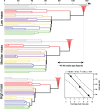Genomic Signature of an Avian Lilliput Effect across the K-Pg Extinction
- PMID: 28973546
- PMCID: PMC5837713
- DOI: 10.1093/sysbio/syx064
Genomic Signature of an Avian Lilliput Effect across the K-Pg Extinction
Abstract
Survivorship following major mass extinctions may be associated with a decrease in body size-a phenomenon called the Lilliput Effect. Body size is a strong predictor of many life history traits (LHTs), and is known to influence demography and intrinsic biological processes. Pronounced changes in organismal size throughout Earth history are therefore likely to be associated with concomitant genome-wide changes in evolutionary rates. Here, we report pronounced heterogeneity in rates of molecular evolution (varying up to $\sim$20-fold) across a large-scale avian phylogenomic data set and show that nucleotide substitution rates are strongly correlated with body size and metabolic rate. We also identify potential body size reductions associated with the Cretaceous-Paleogene (K-Pg) transition, consistent with a Lilliput Effect in the wake of that mass extinction event. We posit that selection for reduced body size across the K-Pg extinction horizon may have resulted in transient increases in substitution rate along the deepest branches of the extant avian tree of life. This "hidden" rate acceleration may result in both strict and relaxed molecular clocks over-estimating the age of the avian crown group through the relationship between life history and demographic parameters that scale with molecular substitution rate. If reductions in body size (and/or selection for related demographic parameters like short generation times) are a common property of lineages surviving mass extinctions, this phenomenon may help resolve persistent divergence time debates across the tree of life. Furthermore, our results suggest that selection for certain LHTs may be associated with deterministic molecular evolutionary outcomes.
Keywords: Birds; K-Pg; body size; divergence times; life history evolution; mass extinction; metabolic rate; molecular clocks.
© The Author(s) 2017. Published by Oxford University Press, on behalf of the Society of Systematic Biologists. All rights reserved. For Permissions, please email: journals.permissions@oup.com.
Figures



References
-
- Alroy J. 1999. The Fossil Record of North American Mammals: evidence for a Paleocene evolutionary radiation. Syst. Biol. 48:107–118. - PubMed
-
- Alvarez L.W.,, Alvarez W.,, Asaro F.,, Michel H.V. 1980. Extraterrestrial Cause for the Cretaceous-Tertiary Extinction. Science, 208:1095–1108. - PubMed
-
- Archibald J.D. 1996. Dinosaur extinction and the end of an era: what the fossils say. New York: Columbia University Press.
-
- Barnosky A.D.,, Matzke N.,, Tomiya S.,, Wogan G.O.U.,, Swartz B.,, Quental T.B.,, Marshall C.,, McGuire J.L.,, Lindsey E.L.,, Maguire K.C.,, Mersey B.,, Ferrer E.A. 2011. Has the Earth’s sixth mass extinction already arrived? Nature 471:51–57. - PubMed
Publication types
MeSH terms
Associated data
Grants and funding
LinkOut - more resources
Full Text Sources
Other Literature Sources

